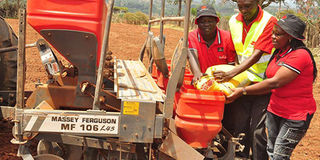Get it right with planters, from use to maintenance

FMD specialists demonstrate planting processes using a planter in this past photograph. When selecting a planter, consider other operations that will be carried out on the farm and to the crop before harvesting, which include, irrigation, pest control and equipment movement. FILE PHOTO | NMG
What you need to know:
- The farmer must also decide if his farm will be running on controlled traffic or not. This will, in many ways, affect how the operations are carried out and demarcation of traffic and non-traffic areas.
- Accordingly, you should make sure that you lubricate all chains and bearings thoroughly. Rust-preventive paint should be applied to the clean disc opener and coulters.
- The adjustment of disc openers or replacement of those worn-out ensure that the furrow will give you accurate seed positioning and firming.
- Make sure that the tyres are inflated to the correct pressure because under, or over inflated tyres influence the accuracy of transmission settings for the seed drop.
The choice and correct usage of a planter are key determinants in achieving the right plant population and, consequently, a good crop. When buying a planter, it is important to consider the size of your farm.
The initial purchase price is crucial, but you also need to consider your expenditure over the next few years on spares, servicing and repairs.
Like all machinery, after the purchase, the aftersales support and availability of spare parts are a key consideration.
The output of your planter should be sufficient for you to take full advantage of the planting window, which is dependent on the size of land and the likely duration of the rainy season.
When selecting the planter, also consider other operations that will be carried out on the farm and to the crop before harvesting, which include, irrigation, pest control and equipment movement.
The farmer must also decide if his farm will be running on controlled traffic or not. This will, in many ways, affect how the operations are carried out and demarcation of traffic and non-traffic areas.
By setting the planter spacing correctly, tasks such as crop spraying can be carried out with minimum damage to crops.
Taking care of a planter
Bearing in mind that a planter represents a significant investment, it is important that you take great care of your equipment.
If possible, store your planter under a roof. When not in use, remove the rubber hoses, grease and cover the chains.
The life of all equipment is extended by correct lubrication and planters are no exception.
Accordingly, you should make sure that you lubricate all chains and bearings thoroughly. Rust-preventive paint should be applied to the clean disc opener and coulters. Plastic hoppers should not be left in the sun for long as they will deteriorate fast.
Tasks to be carried out immediately before planting
Checking the condition of your equipment regularly and replacing all worn-out parts will ensure that your planter is reliable, and you will not suffer problems caused by break downs. Carry out the following tasks:
The adjustment of disc openers or replacement of those worn-out ensure that the furrow will give you accurate seed positioning and firming.
Remember worn-out openers will create a W-shaped furrow instead of the V shape, which you require for best results.
Another cause of reduced seeding accuracy is the inefficient operation of planter chains, which may be worn out, rusty or are stiff.
This is cured by wire brushing and greasing the chains. To avoid the problem occurring, ensure you do correct lubrication at the end of the planting season and keep the chains covered away from dust and debris.
Ensure that coulters and disc openers are correctly aligned to give accurate furrow opening and seed placement.
Make sure that the tyres are inflated to the correct pressure because under, or over inflated tyres influence the accuracy of transmission settings for the seed drop.
Seed tubes and monitor sensors should be cleaned to avoid interference with the accuracy of the sensors.
With finger pickup type planters, the back plates should be clear of rust build up and seed treatment residues.
Tension on the fingers should be checked and adjusted because badly adjusted finger pressure affects the ability of the unit to accurately cingulate seeds.
The writer is a technical manager, FMD East Africa.




